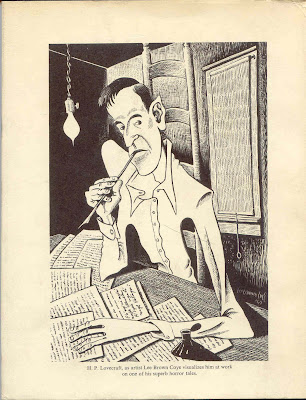 these times, I always owned certain "collectibles" that I could sell off when I had to. I could spend endless days pining away for various rare comics, pieces of original art, rare books, and what-have-you.
these times, I always owned certain "collectibles" that I could sell off when I had to. I could spend endless days pining away for various rare comics, pieces of original art, rare books, and what-have-you.But all during those years, the one book that I could never bring myself to toss into the box with the other stuff I was hauling off to the bookshop or the convention was a single volume published by Arkham House Books. It was:
H.P. LOVECRAFT
THREE TALES OF HORROR
ILLUSTRATED BY
LEE BROWN COYE
For someone who was as interested in weird fiction as I was, there was no more perfect volume than this one. First of all, it was written by Howard Philips Lovecraft who may not have been a genius, but he was certainly brilliant and he was certainly a true artist. What elevated his fiction into the realm of art (and, perhaps, genius) was that he wrote supernatural fiction for atheists.
It's true.
My various religionist friends who also enjoy HPL's work hate it when I point this out, but they can't argue against it effectively. Lovecraft was himself an adamant atheist. But fiction with a supernatural element was a guilty pleasure for him. So he set about writing stories that contained the things we would normally think of as ghosts and demons and gods, but which had about them a certain kind of scientific logic. He succeeded completely in this effort, and weird fiction was left with the kind of story even an atheist could enjoy--and without guilt.
And this book contains three of HPL's finest works. Some would say his three best: "The Colour Out of Space", "The Dunwich Horror", and "The Thing on
 the Doorstep". In the long years since I first discovered Lovecraft's work, I don't enjoy reading most of his fiction anymore. It's tedious stuff, mainly, and it's easy to make light of his heavy prose and sometimes comical use of adjectives. But there is, at its base, some stuff that has stood the test of time and which succeed in horrifying the reader. These three tales do just that.
the Doorstep". In the long years since I first discovered Lovecraft's work, I don't enjoy reading most of his fiction anymore. It's tedious stuff, mainly, and it's easy to make light of his heavy prose and sometimes comical use of adjectives. But there is, at its base, some stuff that has stood the test of time and which succeed in horrifying the reader. These three tales do just that.In addition to all of that, this book was illustrated by Lee Brown Coye. Coye, sadly, is recalled by few these days. Along with HPL, he was probably the only other creator to be published by Weird Tales Magazine who was also something of a genius. Coye's genius lay mainly with his use of pen & ink and his uncanny ability to twist both human anatomy and natural geometry into shapes not intended by genetics. The fact that he was highly familiar with both anatomy and the workings of nature made his attempts so hideously effective. He has remained, after decades, my very favorite illustrator of weird fiction. Some have come close to achieving what Coye could do, but none have equalled his skill or his sheer power.
For these reasons I could never bear to part with this book. In moments of economic stress I would take it down from whatever shelf upon which it was displayed...and no matter how bad things had become, I could never bear to part with this single volume. Each time I would look at it, read some of Lovecraft's phrases, and gaze at Coye's amazing illustrations. And each time I would slide it back to its place on the shelf and there it would remain. As it does today.
2 comments:
I have a pb of Hawthorne's Twice-Told Tales with decent illustrations, but I'd have to go to a different bookshelf and paw through them to tell you the artist's name. Same thingm, though, I save the book because its so rare to see art inside a book from the 1920s.
I have a pb of Hawthorne's Twice-Told Tales with decent illustrations, but I'd have to go to a different bookshelf and paw through them to tell you the artist's name. Same thingm, though, I save the book because its so rare to see art inside a book from the 1920s.
Post a Comment